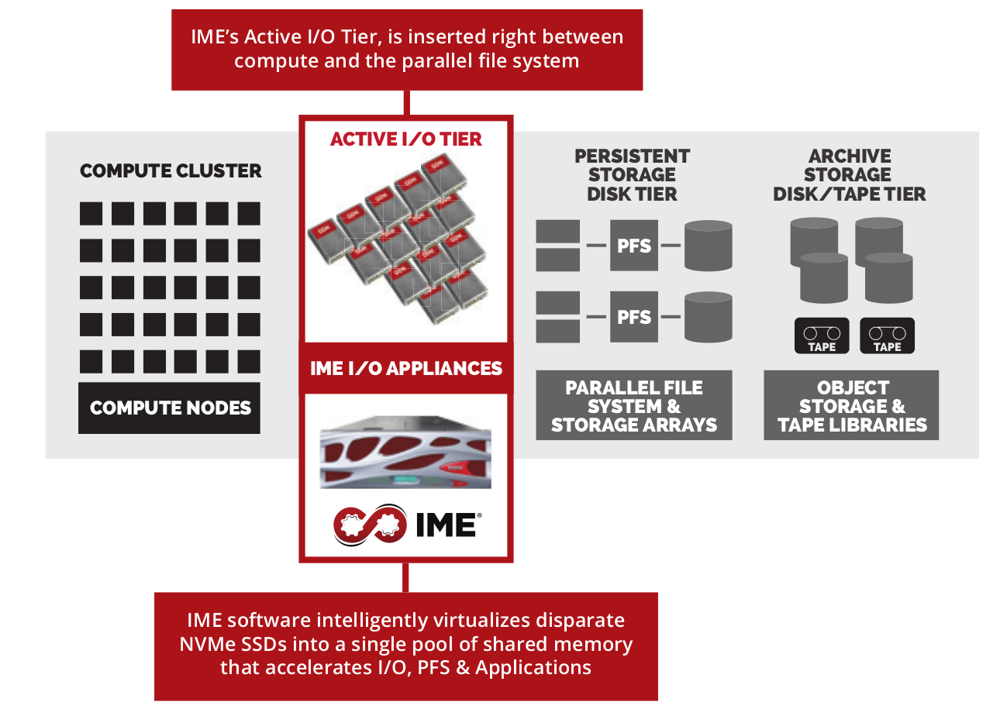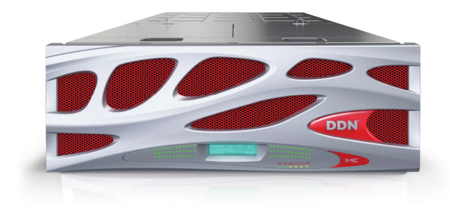DDN IME14K Application and File System Accelerator Software With NVMe and All-Flash Appliance
Accelerates read and write I/O path from compute to persistent storage for HPC.
This is a Press Release edited by StorageNewsletter.com on November 26, 2015 at 2:57 pmDataDirect Networks, Inc.(DDN) announced an advancement enabling HPC and large scale data environments to break free from I/O bottlenecks that are slowing entire data-intensive infrastructures.
Today, the performance demanded by applications and computing has outpaced the performance delivered by traditional storage technologies, creating storage and file system I/O bottlenecks. The IME14K breaks through these bottlenecks and optimizes mixed application workloads to deliver game-changing I/O acceleration for data-intensive environments.
Company’s storage and processing solutions and professional services enable content-rich and high growth IT environments to achieve the highest levels of systems scalability, efficiency and simplicity. The company enables enterprises to extract value and deliver results from their information. Customers include the world’s leading online content and social networking providers, high performance cloud and grid computing, life sciences, financial services, media production, and security and intelligence organizations. Deployed in thousands of mission critical environments worldwide, the solutions have been designed, engineered and proven in the world’s most scalable data centers to ensure competitive business advantage for today’s information powered enterprise.
DDN IME14K
Leveraging the company’s 14K hardware platform and IME software technology, the IME14K appliance optimizes and accelerates the read and write I/O path from compute to persistent storage.
-
IME14K acceleration of compute cluster. The IME14K acts as a burst buffer and optimizes the compute cluster performance as it allows more simultaneous application jobs to run, shortening the job queue and enabling faster application run time for the user.
-
IME14K acceleration writing to persistent file storage. As data is moved from the IME14K NVMe cache to persistent storage, the IME software dynamically reorganizes data into sequential writes, eliminating the latency, thrashing and slow write times created by the fragmented I/O patterns of demanding mixed workload applications leveraging a shared file system. This approach enables the NVMe cache to be offloaded more quickly and helps to avoid the requirement of overprovisioning the file system to achieve the performance needed.
-
IME14K acceleration reading from persistent file storage. An out-of-band API is provided for configuration of the IME appliance with job schedulers and to warm the cache and accelerate first read.
The IME14K all-flash array takes advantage of company’s high-performance, hyper-converged 14K hardware platform, which delivers the NVMe cache on a local PCI-3 embedded fabric, driving low latency, full device performance to each of the NVMe-enabled SSD devices. Each IME14K can be configured to start with a small number of NVMe devices and scales up to 48 NVMe SSD in each 4U appliance. IME14K delivers an expected throughput starting at 10GB/s for entry performance and scales up to 50GB/sec in each 4U appliance. The IME14K is designed to accommodate additional appliances being clustered to deliver thousands of GB/s performance for the most data-intensive workloads on the globe. The IME14K is powered by the company’s patented IME application and file system acceleration software that runs within the storage memory of the appliance on the embedded PCI-e fabric. With IME14K, large scale data-intensive environments have the tools to leverage untapped compute cycles and are able to run more jobs, achieving application efficiency and performance by minimizing I/O bottlenecks and accelerating applications and file systems, while reducing the erratic performance often found in large scale, mixed application environments.
Users benefit from IME14K acceleration capabilities as it:
-
Speeds time to results by accelerating workflows, applications and bottlenecked I/O;
-
Eases data growth by optimizing usage of storage systems; and
-
Increases compute ROI by eliminating I/O wait times and increasing the amount of time that can be utilized for computation.
The IME14K offers customers flexible scalability and the choice of several of the latest, and soon to be released, high-performance interconnects, including: IB EDR, Omni-Path and 100Gb/E. Dual servers, distributed erasure coding and real-time health monitoring increase reliability, availability and service ability (RAS) and provide high-performance data cache with many of the same levels of protection as disk-based persistent storage tiers.
“Over the past few years the performance demanded by applications and computing has outpaced the performance delivered by storage technologies, creating storage system I/O bottlenecks. As speed and scale of environments and applications grow, the negative effects of I/O contention and latency are magnified. To combat this challenge, DDN’s IME14K is redefining the industry’s approach to data-intensive architectures and is enabling new levels of efficiency and capabilities, including higher utilization of compute, optimized use of storage hardware, and faster time to results in areas such as scientific and medical discovery, data analytics and market analysis,” said Molly Rector, CMO, EVP, product management and WW marketing, DDN. “With IME14K, DDN is expanding on its mission to help solve the toughest challenges of Government Labs & Academia, the Enterprise and Web/Cloud organizations.“
The IME14K All-Flash Array appliance powered by IME software is available for limited shipments in fourth quarter 2015 and will be available in the first quarter of 2016.
Resources:
DDN IME14K
DDN IME14K Product Brief
Customer Evaluation of IME (video)















 Subscribe to our free daily newsletter
Subscribe to our free daily newsletter

